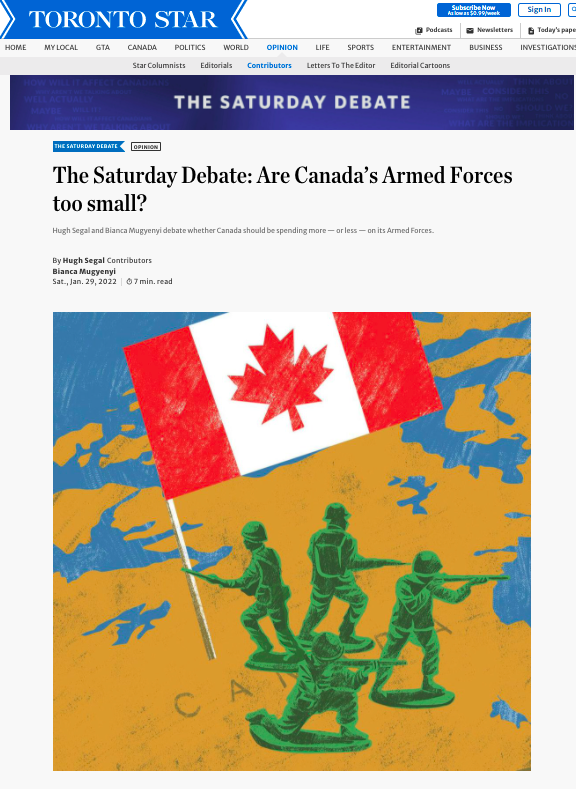Originally published in the Toronto Star, January 29, 2022
By Bianca Mugyenyi, Director, Canadian Foreign Policy Institute
***
Are Canada’s Armed Forces Too Small?
Those who profit from war and weapons sales want us to believe our security is dependent on increased military spending. But, for most Canadians the opposite is true. In addition to a pandemic, our security threats are ecological, social and economic and expanding the largest federal government ministry cannot protect us from these crises.
Canada’s armed forces have 125,000 soldiers, reservists and other staff. The military manages the “largest infrastructure portfolio in the federal government” covering a land mass equal to half of Switzerland. From chemical waste to bomb ordnance, its operations have scarred landscapes across the country. While little discussed, the Department of National Defence is also responsible for a staggering 59% of federal government greenhouse gas emissions.
The environmentally damaging armed forces receive 15 times the public resources allocated to Environment and Climate Change Canada. On the world stage, Canada accounts for 1.1% of international military spending, despite having less than 0.5 percent of the global population. There are only 12 countries that spend more on their militaries than Canada.
In the two largest ever federal government procurements, Ottawa plans to spend a combined $100 billion — $350 billion over their lifecycle — on 88 new fighter jets and 15 surface combatant vessels. The warplanes will carry 18,000 pounds of destructive ordnance. The warships with state-of-the-art radars will allow US officials to launch “Canadian” missiles, including Tomahawk cruise missiles capable of hitting targets 1,700 kilometres away.
Canada’s naval vessels are militarising the seas. Last week, a Canadian naval vessel was dispatched to the Black Sea, which borders Russia. Provocatively, Canadian frigates have recently joined US warships passing through the South China Sea and Taiwan Strait. Canadian warships regularly patrol the North Sea, Mediterranean and Caribbean.
To assist Canada’s global maritime force, small bases have been established in Kuwait, Jamaica and Senegal. Ottawa has also been negotiating to set up four more “lily pads” in Singapore, Germany, Tanzania and South Korea as part of an effort to “project combat power” under the Pentagon’s direction.
While not formally at war, Canadian forces are currently participating in some two dozen international missions. Hundreds of Canadian troops are in Iraq as well as in Latvia and Ukraine, both which border Russia. Smaller numbers assist a Palestinian security force that helps enforce Israel’s occupation of the West Bank and others are part of a mission dating back to the early 1950s Korean war.
Let’s not forget that over the past three decades tens of thousands of Canadians were deployed to fight in Iraq, Serbia, Afghanistan and Libya. What good came of those wars? Thirty years later fighting continues in Iraq while ethnic tensions simmer in Kosovo. The 2011 NATO bombing of Libya led to slave markets and an ongoing civil war. In Afghanistan, the newly dominant Taliban appears moderate compared to ISIS-K.
Canadian forces have also caused major harm in places while barely firing a shot. In 2004, for instance, thirty Canadian JTF 2 commandos “secured” the Port-au-Prince airport the night US Marines exiled Haiti’s elected leftist president Jean-Bertrand Aristide to the Central African Republic. Following this, 500 Canadian troops protected Haiti’s foreign installed government for six months as it suppressed the democracy movement.
Six years later, when a devastating earthquake killed tens of thousands, Canada did not send its Heavy Urban Search and Rescue Teams. Instead, they dispatched 2,000 troops to Haiti, which largely policed a traumatised population. Internal government documents examined by The Canadian Press revealed Ottawa feared a post-earthquake power vacuum could lead to a “popular uprising.” A “secret” briefing noted, “Political fragility has increased the risks of a popular uprising and has fed the rumour that ex-president Jean-Bertrand Aristide, currently in exile in South Africa, wants to organise a return to power.”
Canada’s military isn’t designed to defend against a foreign aggressor, let alone protect citizens from pressing security concerns like a life altering pandemic or ever worsening climate breakdown. It is structured to aid US military aims.
Few nations possess naval vessels capable of launching missiles 1,700 kms. Canada’s Five Eyes counterpart New Zealand, North America trade partner Mexico and European ally Ireland don’t have operational fighter jets. Thirty countries, including Costa Rica, Panama and Iceland, have no military at all.
Let’s get our priorities straight. We need less, not more, spending on Canada’s military.

